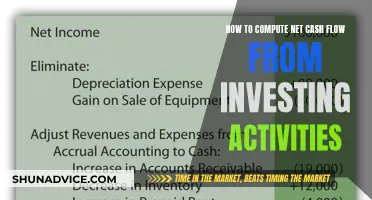
Individual Savings Accounts (ISAs) are a popular way of saving money for the future, thanks to their tax benefits. You can withdraw money from most ISAs at any time without losing tax benefits or incurring penalties. However, there are different rules for Lifetime ISAs, which are designed to help with purchasing your first home or saving for retirement. It's important to check the terms of your ISA to see if there are any rules or charges for making withdrawals. In this article, we will explore the process of cashing in an investment ISA, including the different types of ISAs, the impact on tax benefits, and the potential fees involved.
| Characteristics | Values |
|---|---|
| Tax on withdrawal | No tax on withdrawal |
| Time taken for withdrawal | 1-2 working days for cash ISA, 3-7 working days for stocks and shares ISA |
| Minimum withdrawal amount | Varies by type and provider, e.g. £10 for easy-access cash ISA from the Post Office |
| Maximum withdrawal amount | No limit |
| Fee | No fee for ii Stocks and Shares ISA and John Lewis Investments Stocks and Shares ISA |
| Effect on annual allowance | Flexible ISA: no effect; Non-flexible ISA: affects allowance |
What You'll Learn

Withdrawing from a Junior ISA
Withdrawals from a Junior ISA are typically restricted until the child turns 18. At this point, the account holder can withdraw money from the account, which is converted into an adult ISA with different terms and conditions. It's important to note that parents or guardians cannot access the account or withdraw funds, except in specific circumstances.
Exceptional Circumstances:
In the unfortunate event of the child's terminal illness or death, withdrawals can be made by the registered contact. This typically requires providing appropriate documentation, such as a letter from HMRC or a death certificate. It's important to contact the ISA provider for guidance and support in these situations.
Withdrawal Process:
The specific steps for withdrawing money from a Junior ISA may vary depending on the provider. Generally, once the child reaches the age of 18, they can log in to their account and select the 'Withdraw Money' option. They will need to review and accept the ISA withdrawal warning, which states that withdrawn funds cannot be replaced in the ISA without using the annual allowance. After confirming the amount and agreeing to the terms and conditions, the withdrawal can be finalised.
Tax Implications:
Withdrawals from most ISAs, including Junior ISAs, do not incur tax payments. Any profits made in the ISA account are typically tax-free. However, it's important to note that there may be ISA withdrawal fees, depending on the type of ISA and the provider. These fees should be checked before making a withdrawal to avoid unexpected costs.
Understanding Cash Flow from Sales of Investments
You may want to see also

Stocks and Shares ISA withdrawal
Withdrawing money from a Stocks and Shares ISA is a straightforward process, but there are a few things to keep in mind. Firstly, it's important to understand the rules and potential fees associated with withdrawing from this type of ISA. Stocks and Shares ISAs are considered a 'tax wrapper', meaning any investment growth or interest earned within the ISA is free of tax. With that in mind, you can withdraw from most ISAs at any time without affecting the tax benefits.
The process of withdrawing money can vary depending on the provider, but generally, you will need to log in to your account online or via a mobile app, select the account you want to withdraw from, and then follow the prompts to withdraw cash. You will need to have a nominated bank account set up before making a withdrawal. It's worth noting that withdrawing money from a Stocks and Shares ISA means you will need to sell some or all of your shares, and the proceeds will be transferred to your bank account. This can take a few days, and the value of your shares may have decreased since you purchased them.
It's also important to understand the impact of timing on your withdrawals. Withdrawing money from your ISA will reduce the amount of funds in the account, which can significantly affect how much your investment grows over time, especially with the benefit of compound interest. Additionally, if you withdraw money from a non-flexible ISA, you will not be able to replace that money in the same tax year without using your annual allowance.
Finally, while there are no taxes on ISA withdrawals, some wealth managers and providers may charge a fee for withdrawing money from a Stocks and Shares ISA, so be sure to check the terms and conditions carefully.
Dividends: Cash Flow from Investing?
You may want to see also

Cash ISA withdrawal
You can withdraw from most Cash ISAs at any time without affecting the tax benefits. However, there are different rules for Lifetime ISAs. You can only withdraw money from a Lifetime ISA to buy your first home or after you turn 60. If you withdraw money from a flexible ISA, you can replace that money in your ISA without using your annual allowance. If your ISA is not flexible, you cannot replace the money you have withdrawn without using your annual allowance.
You do not pay tax when you withdraw money from a Cash ISA. However, your money loses its tax-free status once you withdraw it. So, if you have exhausted your annual ISA allowance, you won't be able to redeposit it in another one. You may need to pay tax on any earnings if you place it in another type of savings account.
There may be penalties for withdrawing money from fixed cash ISAs, Lifetime ISAs, and Help to Buy ISAs. Some providers may charge a fee for cash withdrawals, so it is best to check before making a withdrawal. If you have a fixed-term ISA, you will need to wait until your agreed term is over before withdrawing your money unless you pay a fee. The cost of this will depend on your ISA provider and your initial agreement.
To withdraw money from a Stocks and Shares ISA, you need to have set up a nominated bank account. You can then log in online, select the account you want to withdraw from, and select 'Withdraw money'. After reading the ISA withdrawal warning, you can enter the amount you want to withdraw and confirm the payment. Depending on when you make the withdrawal, the money will usually reach your nominated bank account either later that day or the next working day.
Positive Cash Flows: A Smart Investment Strategy?
You may want to see also

Lifetime ISA withdrawal
A Lifetime ISA is a type of Individual Savings Account (ISA) designed to help individuals save for their first home or retirement. It offers a generous government bonus of up to £32,000 on savings of up to £4,000 per year. However, there are specific rules and restrictions regarding withdrawals from a Lifetime ISA.
Firstly, it's important to note that you can only withdraw money from a Lifetime ISA under specific circumstances: buying your first home or after turning 60 years old. Withdrawing funds for any other reason will incur a penalty. The penalty includes a 25% charge on the amount withdrawn, which could result in getting back less than you paid in. Therefore, it's essential to consider the purpose of your Lifetime ISA before making any withdrawals.
If you are withdrawing to purchase your first home, you must ensure that the property meets the eligibility criteria. This includes a maximum property price of £450,000 and the requirement that the property must be used as your main residence. You can choose to withdraw the entire amount or only a portion of your savings. The process typically involves contacting your Lifetime ISA provider and providing the necessary documentation to prove that you are a first-time buyer.
Withdrawing from your Lifetime ISA after turning 60 is a more straightforward process. You can access your savings without penalty and use the funds for any purpose. This can be a valuable source of retirement income, providing tax-free money to supplement your pension. It's worth noting that you don't need to cash in your Lifetime ISA as soon as you turn 60; you can choose to keep it open and continue benefiting from tax-efficient growth.
It's important to remember that the rules and charges associated with Lifetime ISA withdrawals may vary depending on your provider. Therefore, it's always advisable to check the terms and conditions of your specific Lifetime ISA account before making any withdrawal decisions. Additionally, the flexibility of your ISA can impact how withdrawals affect your annual allowance. With a flexible ISA, you can withdraw and then replace the funds within the same tax year without reducing your current year's allowance. In contrast, with a non-flexible ISA, you cannot replace withdrawn funds without utilising your annual allowance.
Understanding Cash Flows from Investing Activities
You may want to see also

ISA withdrawal fees
There are various rules to consider when withdrawing funds from an individual savings account (ISA). Whether you incur a penalty when withdrawing money will depend on the type of ISA. Even if you can do it without a fee, you should consider how it affects your tax-free ISA allowance.
You can take your money out of an ISA at any time without losing any tax benefits. However, you should check the terms of your ISA to see if there are any rules or charges for making withdrawals. If you have a fixed-term ISA, you can still withdraw money before your agreed term ends, but you will likely be liable for an early withdrawal charge.
If you have a Lifetime ISA, there are different rules for taking your money out. You can only withdraw money from a Lifetime ISA to buy your first home or after you turn 60. Withdrawals or transfers to another type of ISA outside of this are subject to a 25% charge.
If your ISA is 'flexible', you can take out cash and then put it back in during the same tax year without reducing your current year's allowance. Your provider can tell you if your ISA is flexible. For example, if your allowance is £20,000 and you put £10,000 into an ISA during the 2024-2025 tax year, you can then take out £3,000. The amount you can now put back in during the same tax year is £13,000 if your ISA is flexible (the remaining allowance of £10,000 plus the £3,000 you took out).
Understanding the Relationship Between Cash and Investments
You may want to see also
Frequently asked questions
Yes, you can withdraw money from an Investment ISA at any time. However, there may be specific rules and charges for making withdrawals, depending on the type of ISA you have.
The process for withdrawing money from an Investment ISA varies depending on the provider. Typically, you will need to log in to your account online or via a mobile app, select the account you want to withdraw from, and then follow the instructions to make a withdrawal. In some cases, you may need to sell your investments before you can withdraw the money.
There may be fees or charges for withdrawing money from an Investment ISA, depending on the type of ISA and the provider. Some providers may charge a withdrawal fee, while others may impose a penalty for withdrawing money from a fixed-rate ISA before the end of the fixed term. It is important to check the terms and conditions of your ISA before making a withdrawal.







